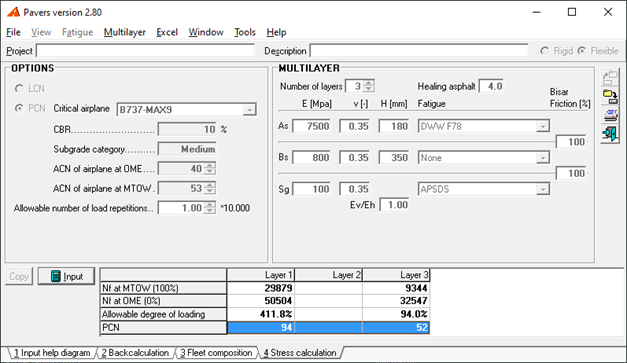The Pavement Classification Number
The ACN/PCN method is strict towards the ACN procedure, but allows the airport to choose for any method suit-able for the determination of the pavement load bearing capacity or PCN. However, ICAO’s Aerodrome Design Manual, Doc. 9157-AN/901, part 3 Pavements and Aerodromes, Annex 14 to the Convention on International Civil Aviation presents some guidance for the PCN determination.
Some guidance to PCN assignment
ICAO requires that the strength of pavements for aircraft with mass greater than 12,500 lb ( 5,700 kg) be made available using ACN-PCN method by reporting all of the following information:
- Pavement Classification Number
- Pavement type
- Subgrade strength category
- Maximum allowable tire pressure category or maximum allowable tire pressure value
- Evaluation method
The bearing strength of airfield pavements must be measured, analyzed, evaluated and reported so that the operating weight of aircraft allowed to use the pavements can be controlled. The PCN number indicates the suitability of a pavement area for unrestricted operations by any aircraft that has an ACN and tire pressure not exceeding the limits reported in PCN format of stated pavement type and subgrade strength category. The method of PCN pavement evaluation is left up to the airport, under the approval of the regulating CAA. Some guidance to the selection of an appropriate PCN is provided in Chapter 3, ‘Evaluation of pavements’ of the Aerodrome design manual Although ICAO does not give specified regulatory guidance on how to determine a PCN, it states that the PCN must represent a relation between allowable load i.e. the ACN of the critical i.e. most damaging aircraft and the structural pavement life:
- The PCN is to be based on the ACN values of the most damaging aircraft(s) that use the pavement on a regular basis (regular being defined by the operator).
- The PCN determination must consider the number of coverage’s during the pavement’s life.
Pls. Note that the most damaging aircraft doesn't have to be the aircraft within the fleet mix having the highest ACN. The critical aircraft for PCN evaluation is the aircraft resulting in the highest damage af all aircraft within the fleet mix. An analytical technical evaluation is preferred over empirical methods (i.e. CBR-method), revealing the true material strength using calibrated failure criteria for all pavement materials and subgrade.
In the most fundamental terms, the determination of a rating in terms of PCN is a process of deciding on the maximum allowable gross weight of a selected critical airplane for a pavement knowing its ACN at that weight, reporting it as PCN. This process can be as simple as knowing the operational gross weight of each aircraft that is currently using the pavement and looking up its ACN (referred to as the Using aircraft method). This method can be applied with limited knowledge of the existing aircraft and pavement characteristics. The second method is more complex and referred to as Technical evaluation. In order to be successfully implemented, the technical evaluation requires an intimate knowledge of the pavement and its traffic, as well as basic understanding of engineering methods that are utilized in pavement design.
The ICAO PCN pavement strength reporting system involves publishing a five (5) part strength code in the form of 51 FDWT for flexible pavements or 62 R/B/W/T for rigid concrete pavements. If desired, PCNs may be published to an accuracy of 1/10th of a whole number. Briefly, the first number is the reported PCN value on a scale of 1 to about 130, with 1 representing a weak pavement and 130 a very strong pavement. The second part of the code is either an "F" for flexible pavement systems or "R" for rigid pavement systems. The third part is a letter code A, B, C, or D indicating the subgrade/bearing strength, with A representing a high supporting strength and D a very low strength. The fourth part indicates the tire pressure limitation in MPa if applicable (X, Y, Z otherwise W). The fifth and final part of the PCN code indicates the evaluation method used to determine the pavement strength - "T" if derived from an engineering study or "U" if based on satisfactory aircraft usage.
PCN reporting format

Example of reporting PCN
A flexible pavement with 10.000 equivalent passes of an B737-Max9, a subgrade CBR of 10, a numeric value of 52 determined by a technical method, and having an allowable tire pressure of 1,6 MPa is reported as 52/F/B/X/T.

